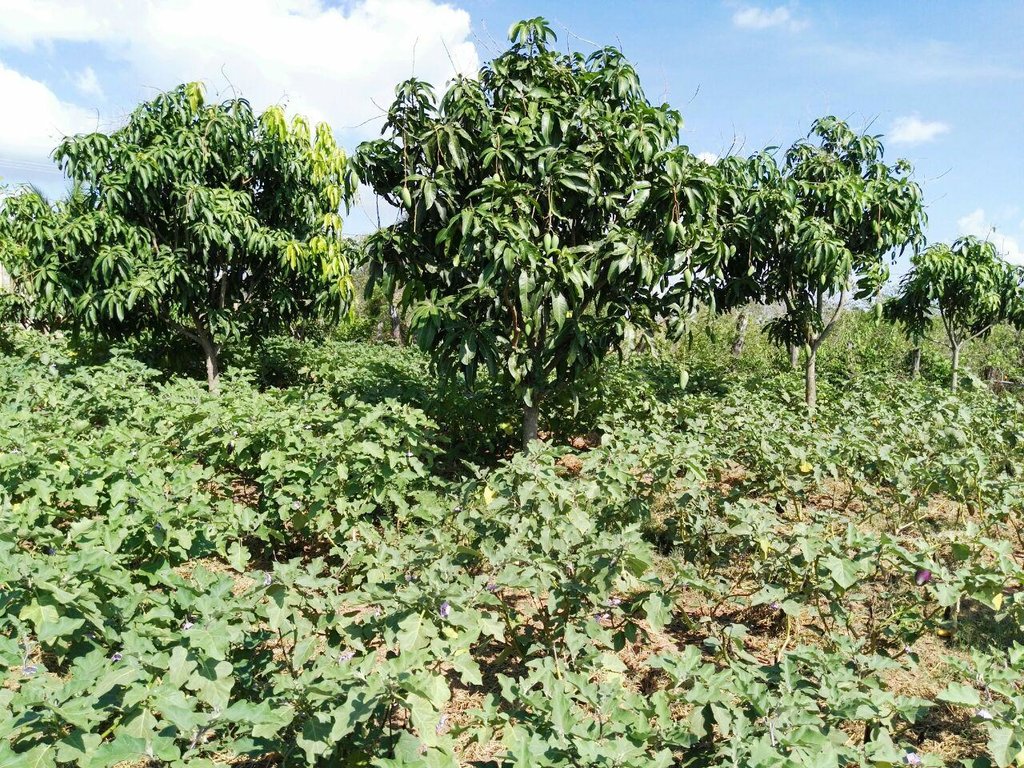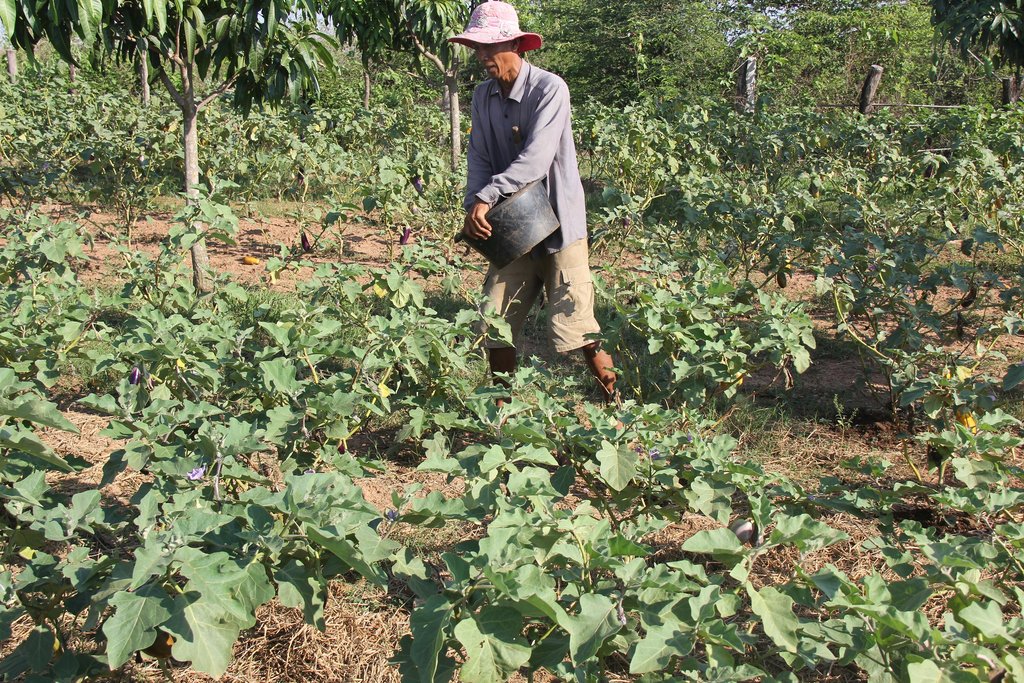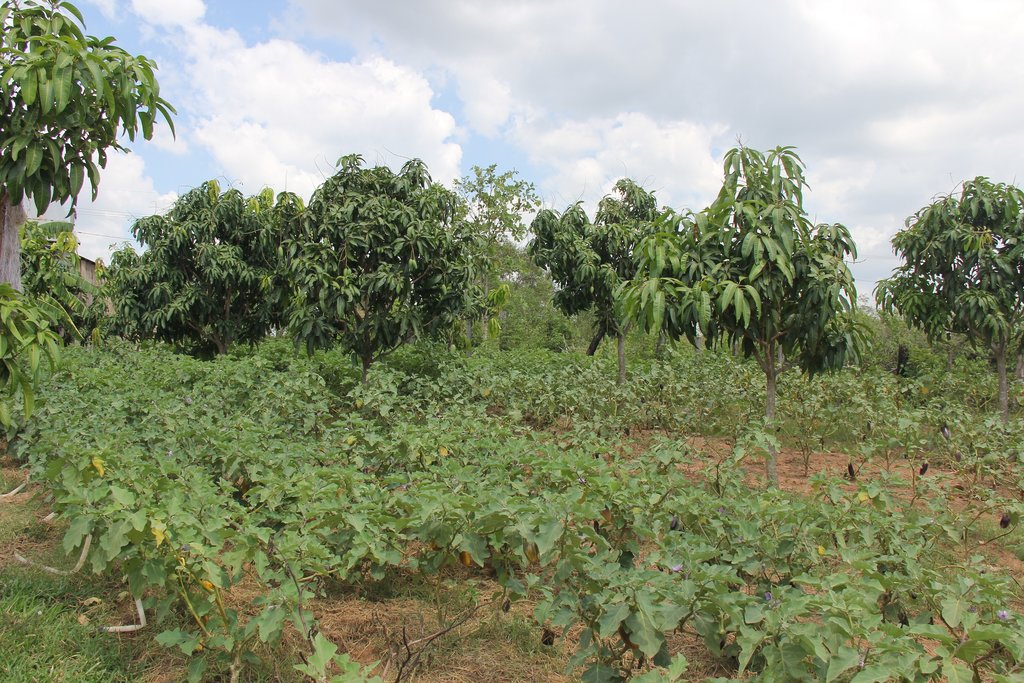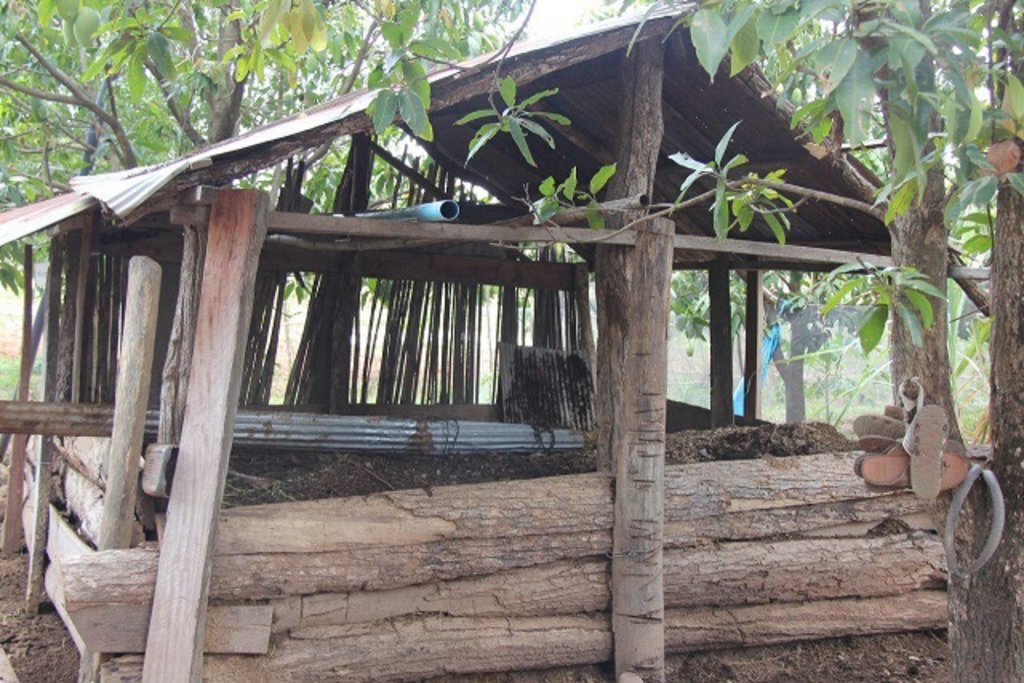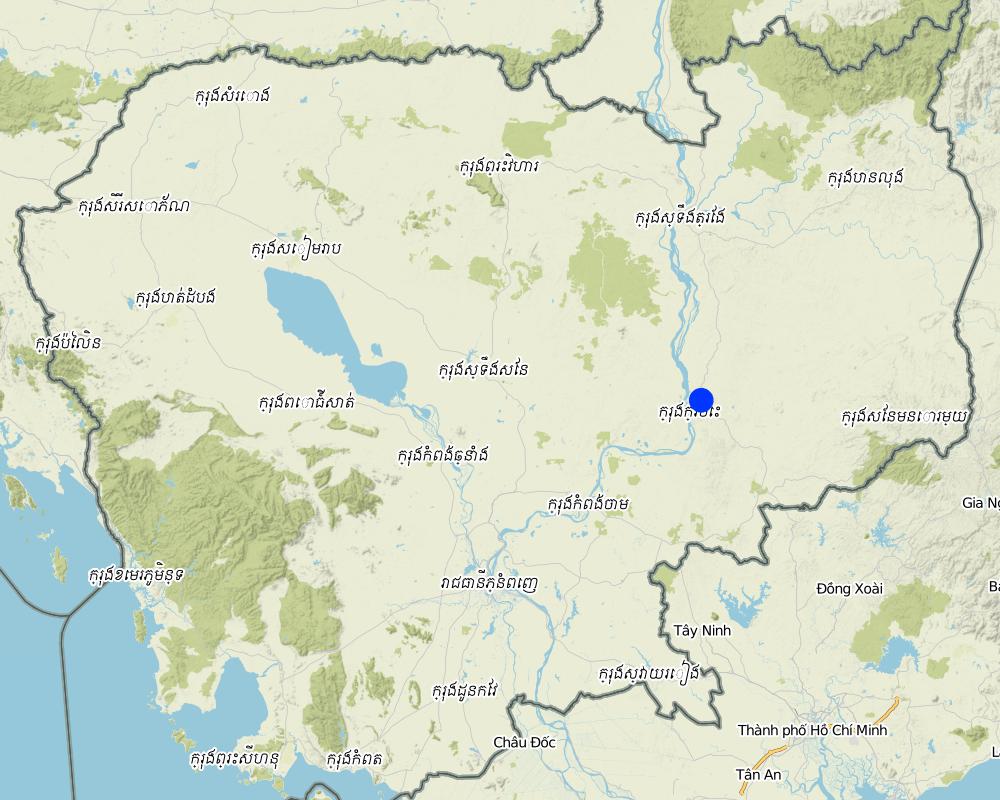Intercropping of eggplants between mango trees using rice straw mulching to reduce evaporation [Cambodia]
- Creation:
- Update:
- Compiler: Navin Chea
- Editors: Sophea Tim, Sok Pheak
- Reviewers: TOM SAY, SO Than
Growing eggplant under mango trees
technologies_2255 - Cambodia
- Full summary as PDF
- Full summary as PDF for print
- Full summary in the browser
- Full summary (unformatted)
- Intercropping of eggplants between mango trees using rice straw mulching to reduce evaporation: Nov. 18, 2017 (inactive)
- Intercropping of eggplants between mango trees using rice straw mulching to reduce evaporation: Nov. 18, 2017 (inactive)
- Intercropping of eggplants between mango trees using rice straw mulching to reduce evaporation: March 1, 2018 (inactive)
- Intercropping of eggplants between mango trees using rice straw mulching to reduce evaporation: Sept. 2, 2019 (public)
View sections
Expand all Collapse all1. General information
1.2 Contact details of resource persons and institutions involved in the assessment and documentation of the Technology
Key resource person(s)
Official of Chetr Borei district office of agriculture, forestry and fisheries:
Ly Saravuth
(+855) 89 796 786) / n/a
saravuthly123@gmail.com / n/a
Chetr Borei district office of agriculture, forestry and fisheries
Khsar village, Dar commune, Chetr Borei district, Kratie
Cambodia
Acting chief of Preaek Prasab District Office of Agriculture, Forestry and Fisheries:
land user:
Yarn Sopheak
(+855)17 834 572 / n/a
n/a / n/a
Farmer
Kamboa village, Kou Loab commune, Chetr Borei district, Kratie
Cambodia
Cambodia
Name of project which facilitated the documentation/ evaluation of the Technology (if relevant)
Scaling-up SLM practices by smallholder farmers (IFAD)Name of the institution(s) which facilitated the documentation/ evaluation of the Technology (if relevant)
Royal University of Agriculture (RUA) - Cambodia1.3 Conditions regarding the use of data documented through WOCAT
When were the data compiled (in the field)?
09/04/2017
The compiler and key resource person(s) accept the conditions regarding the use of data documented through WOCAT:
Yes
1.4 Declaration on sustainability of the described Technology
Is the Technology described here problematic with regard to land degradation, so that it cannot be declared a sustainable land management technology?
No
2. Description of the SLM Technology
2.1 Short description of the Technology
Definition of the Technology:
Intercropping of eggplants between mango trees and the application of straw mulching on the plants’ roots and the land so as to retain soil moisture by reducing heat-induced evaporation. When the rice straw rots, it provides organic matter and makes soil less compact. The farmer can benefit from the short-term crop for a period of three years before the mango trees fully produce fruits.
2.2 Detailed description of the Technology
Description:
Intercropping of a short term crop between the fruit trees which are the long term crop (mango trees which will provide fruit in their third year depending on the species variety and maintenance) is a best agroforestry practice which provides both economic and environmental benefits. When the mango trees are still young and have not yet produced fruit, there is also free space between the trees. In order to gain additional benefits and to avoid weeds growing that could be harmful to the mango trees, the growing of eggplants with rice straw mulching could provide co-benefits in the form of maintaining, weed control, watering, and the application of fertilizer for the mango trees. The eggplants could produce fruit within three months after having been planted and they can be harvested for several months in a year. In this way farmers can generate income for their daily expenditure before the mango trees produce fruit. By using this technology, farmers are able to improve their livelihoods compared with before.
In this SLM technology, the mango trees, eggplants and mulched rice straw interact beneficially. In the dry season, the trees provide some shade for the eggplants and the rice straw on the eggplants' roots and land helps retain soil moisture reducing evaporation, and this prevents the crops from withering during hot days. In addition, when the farmer waters the eggplant,it also provides water to the trees. In rainy season, the rice straw and the eggplants act as an important vegetation cover for the prevention of soil erosion through surface run-off during heavy rainfall. Besides the rice straw and its decayed materials are a crucial food source for micro-organisms in the soil that improve the cycling of nutrients and the soil less compact, enabling a better growth of the crops.
In this technology, the mango trees are planted in row with an interval of six metres and the eggplants are transplanted among the rows of trees ensuring that there is a distance of one metre between each plant within a row, and a distance of 1.5 metres between one row and another. The pit for each mango tree is 70x70x70cm and a mixture of burned rice husk, cow manure and woody herb is added as fertilizer in the bottom of the pit. When planting, the compost or slurry from the of the bio-digester is also mixed in with the soil. Eggplant seedlings are transplanted in 10-cm holes using 20-30 day-old seedlings. Then the farmer applied rice straw mulching on the roots of eggplant and mango trees' roots and applied on the free space of the land. The transplanted eggplants are watered on a daily basis, while the watering of the mango trees is carried out twice per week.
Weeding is done regularly so that the weeds do not absorb too many nutrients from the soil even there is no much weed. The farmer applies compost twice a year, usually once at the beginning of the rainy season in May, and also in October.
When the eggplants start to produce fruit, it takes around one hour for the farmer to harvest the crop on a daily basis. Weeding is sometimes carried out during the harvest. It is suggested that one should consider a rotation of short-term crops in order to maximize the benefits of this SLM technology, because growing one type of crop could absorb exact the same nutrients from the soil so the second crop growing are not very good and could cause disease outbreak on the crop. The rotation of crops in this case could include eggplants, mung beans, sweet corn or cucumbers. However it should examining the market demands as well.
2.3 Photos of the Technology
2.5 Country/ region/ locations where the Technology has been applied and which are covered by this assessment
Country:
Cambodia
Region/ State/ Province:
Kamboa village, Kou Loab commune, Chetr Borei district, Kratie
Further specification of location:
Field
Comments:
This technology is practiced on a crop land behind the house.
Map
×2.6 Date of implementation
Indicate year of implementation:
2012
2.7 Introduction of the Technology
Specify how the Technology was introduced:
- through projects/ external interventions
Comments (type of project, etc.):
The farmer used to join a field visit to Battambang province supported by SNV in CHAIN project coordinated by Chetr Borei District Office of Agriculture, Forestry and Fisheries.
3. Classification of the SLM Technology
3.1 Main purpose(s) of the Technology
- improve production
- reduce, prevent, restore land degradation
- create beneficial economic impact
- Obtaining economic benefits from the short-term crops while the mango is not ready to produce fruits, and the rice straw helps reduce evaporation maintaining soil moisture.
3.2 Current land use type(s) where the Technology is applied

Cropland
- Annual cropping
- Tree and shrub cropping
- Short-term crops
Main crops (cash and food crops):
Mango (producing fruits after 3 years) and eggplant (getting harvest after a month and continue for several months)

Mixed (crops/ grazing/ trees), incl. agroforestry
- Agroforestry
Main products/ services:
Mango and eggplant
If land use has changed due to the implementation of the Technology, indicate land use before implementation of the Technology:
Degraded forest
3.3 Further information about land use
Water supply for the land on which the Technology is applied:
- mixed rainfed-irrigated
Comments:
Pond and wells, but the wells went dry in 2016.
Number of growing seasons per year:
- 1
Specify:
Mango is a long-term crop, eggplant (4 months), sweet corn (2 months), mung bean (2 months)
Livestock density (if relevant):
19 cows and the manure is used in biodigester production
3.4 SLM group to which the Technology belongs
- agroforestry
- improved ground/ vegetation cover
- integrated soil fertility management
- Rice straw helps keep soil moisture and it become organic fertilizer when decays
3.5 Spread of the Technology
Specify the spread of the Technology:
- evenly spread over an area
If the Technology is evenly spread over an area, indicate approximate area covered:
- < 0.1 km2 (10 ha)
Comments:
Land area for applying the technology is 35 x 70 m = 2450 square meter.
3.6 SLM measures comprising the Technology

agronomic measures
- A1: Vegetation/ soil cover
- A2: Organic matter/ soil fertility
- A3: Soil surface treatment

vegetative measures
- V1: Tree and shrub cover
- V2: Grasses and perennial herbaceous plants
3.7 Main types of land degradation addressed by the Technology

soil erosion by water
- Wt: loss of topsoil/ surface erosion

chemical soil deterioration
- Cn: fertility decline and reduced organic matter content (not caused by erosion)

physical soil deterioration
- Pc: compaction
- Pu: loss of bio-productive function due to other activities

biological degradation
- Bc: reduction of vegetation cover
- Bl: loss of soil life
- Bp: increase of pests/ diseases, loss of predators

water degradation
- Ha: aridification
3.8 Prevention, reduction, or restoration of land degradation
Specify the goal of the Technology with regard to land degradation:
- reduce land degradation
- restore/ rehabilitate severely degraded land
Comments:
In this area, the soil has low fertility. The use of compost from the biodigester and rotating the short-term crops helps improve soil quality.
4. Technical specifications, implementation activities, inputs, and costs
4.1 Technical drawing of the Technology
4.2 Technical specifications/ explanations of technical drawing
The technology contains the 25 total planted mango trees and 350 eggplants. The area of applying this technology is 600 square meters( width 15 meters and length 40 meters).
4.3 General information regarding the calculation of inputs and costs
Specify how costs and inputs were calculated:
- per Technology area
Indicate size and area unit:
600 square meter
If using a local area unit, indicate conversion factor to one hectare:
1 hectare = 10,000 square meters
other/ national currency (specify):
Khmer Riel
Indicate exchange rate from USD to local currency (if relevant): 1 USD =:
4000.0
Indicate average wage cost of hired labour per day:
30,000 Riel
4.4 Establishment activities
| Activity | Type of measure | Timing | |
|---|---|---|---|
| 1. | Ploughing the soil to sun dry | Agronomic | May |
| 2. | Digging the pits for mango trees | Structural | May |
| 3. | Applying the mixture of cow manure, burned rice hush and tree leaves in the pits | Agronomic | May |
| 4. | Planting the mango trees | Agronomic | May |
| 5. | Applying compost | Agronomic | June |
| 6. | Prepare the soil to grow the crops | Structural | June |
| 7. | Digging holes and transplant eggplant | Agronomic | June |
| 8. | Spreading the rice straw | Agronomic | June |
4.5 Costs and inputs needed for establishment
| Specify input | Unit | Quantity | Costs per Unit | Total costs per input | % of costs borne by land users | |
|---|---|---|---|---|---|---|
| Labour | Ploughing the soil to sun dry | Day | 0.5 | 20000.0 | 10000.0 | 100.0 |
| Labour | Digging the pits for mango trees | Pit | 35.0 | 5000.0 | 175000.0 | 100.0 |
| Labour | Applying fertilizers | Day | 0.5 | 20000.0 | 10000.0 | 100.0 |
| Plant material | Mango trees | Tree | 25.0 | 8000.0 | 200000.0 | 100.0 |
| Plant material | Eggplant seeds | Bag | 1.0 | 8000.0 | 8000.0 | 100.0 |
| Fertilizers and biocides | lime | kg | 25.0 | 2000.0 | 50000.0 | 100.0 |
| Fertilizers and biocides | Compost from bidigester | Tank | 50.0 | 2000.0 | 100000.0 | 100.0 |
| Construction material | Hoe | Piece | 2.0 | 20000.0 | 40000.0 | 100.0 |
| Construction material | Carriers | Paire | 1.0 | 7000.0 | 7000.0 | 100.0 |
| Construction material | Soil digger | Piece | 1.0 | 25000.0 | 25000.0 | 100.0 |
| Total costs for establishment of the Technology | 625000.0 | |||||
Comments:
The farmer pays for the expense to create the technology using his own saving, the compost is own produced from the biodigester, which was supported by a project.
4.6 Maintenance/ recurrent activities
| Activity | Type of measure | Timing/ frequency | |
|---|---|---|---|
| 1. | Check the crops regularly | Management | Once every 5 days |
| 2. | Soil preparation after each short-term crop's harvest | Agronomic | After harvest |
| 3. | Making small pit around the mango tree | Management | Dry season |
| 4. | Apply compost | Agronomic | May and October |
| 5. | Watering the crops | Agronomic | Daily especially in dry season |
| 6. | Purchase pumping machine | Management | After growing mango trees |
Comments:
The pumping machine costs 1,600,000 Riel
4.7 Costs and inputs needed for maintenance/ recurrent activities (per year)
If possible, break down the costs of maintenance according to the following table, specifying inputs and costs per input. If you are unable to break down the costs, give an estimation of the total costs of maintaining the Technology:
2800000.0
Comments:
The pumping machine costs 1,600,000 Riel.
4.8 Most important factors affecting the costs
Describe the most determinate factors affecting the costs:
Cost of mango trees and pumping machine.
5. Natural and human environment
5.1 Climate
Annual rainfall
- < 250 mm
- 251-500 mm
- 501-750 mm
- 751-1,000 mm
- 1,001-1,500 mm
- 1,501-2,000 mm
- 2,001-3,000 mm
- 3,001-4,000 mm
- > 4,000 mm
Specify average annual rainfall (if known), in mm:
1138.20
Specifications/ comments on rainfall:
In 2015 the annual rainfall is 1138.2 mm, in 2014 is 1696.50, in 2013 is 1661.8 mm.
Indicate the name of the reference meteorological station considered:
Department of Meteorology, Ministry of Water Resources and Meteorology (2015)
Agro-climatic zone
- sub-humid
There are two seasons: dry and rainy seasons
5.2 Topography
Slopes on average:
- flat (0-2%)
- gentle (3-5%)
- moderate (6-10%)
- rolling (11-15%)
- hilly (16-30%)
- steep (31-60%)
- very steep (>60%)
Landforms:
- plateau/plains
- ridges
- mountain slopes
- hill slopes
- footslopes
- valley floors
Altitudinal zone:
- 0-100 m a.s.l.
- 101-500 m a.s.l.
- 501-1,000 m a.s.l.
- 1,001-1,500 m a.s.l.
- 1,501-2,000 m a.s.l.
- 2,001-2,500 m a.s.l.
- 2,501-3,000 m a.s.l.
- 3,001-4,000 m a.s.l.
- > 4,000 m a.s.l.
Indicate if the Technology is specifically applied in:
- not relevant
5.3 Soils
Soil depth on average:
- very shallow (0-20 cm)
- shallow (21-50 cm)
- moderately deep (51-80 cm)
- deep (81-120 cm)
- very deep (> 120 cm)
Soil texture (topsoil):
- medium (loamy, silty)
Soil texture (> 20 cm below surface):
- fine/ heavy (clay)
Topsoil organic matter:
- low (<1%)
If available, attach full soil description or specify the available information, e.g. soil type, soil PH/ acidity, Cation Exchange Capacity, nitrogen, salinity etc.
In the past, this area was degraded forest. Soil quality is low and contains some stone. After using compost and apply the technology the soil quality has been improved.
5.4 Water availability and quality
Ground water table:
5-50 m
Availability of surface water:
good
Water quality (untreated):
good drinking water
Is water salinity a problem?
No
Is flooding of the area occurring?
No
Comments and further specifications on water quality and quantity:
Groundwater in this area contains some minerals, so the farmer store it in a pond before irrigating to the crops. Rainwater and tape water from other areas is the source of drinking water.
5.5 Biodiversity
Species diversity:
- low
Habitat diversity:
- low
5.6 Characteristics of land users applying the Technology
Sedentary or nomadic:
- Sedentary
Market orientation of production system:
- commercial/ market
Off-farm income:
- > 50% of all income
Relative level of wealth:
- rich
Individuals or groups:
- individual/ household
Level of mechanization:
- manual work
- mechanized/ motorized
Gender:
- women
Age of land users:
- middle-aged
Indicate other relevant characteristics of the land users:
He is 45 years old.
5.7 Average area of land owned or leased by land users applying the Technology
- < 0.5 ha
- 0.5-1 ha
- 1-2 ha
- 2-5 ha
- 5-15 ha
- 15-50 ha
- 50-100 ha
- 100-500 ha
- 500-1,000 ha
- 1,000-10,000 ha
- > 10,000 ha
Is this considered small-, medium- or large-scale (referring to local context)?
- medium-scale
5.8 Land ownership, land use rights, and water use rights
Land ownership:
- individual, titled
Land use rights:
- individual
Water use rights:
- individual
5.9 Access to services and infrastructure
health:
- poor
- moderate
- good
education:
- poor
- moderate
- good
technical assistance:
- poor
- moderate
- good
employment (e.g. off-farm):
- poor
- moderate
- good
markets:
- poor
- moderate
- good
energy:
- poor
- moderate
- good
roads and transport:
- poor
- moderate
- good
drinking water and sanitation:
- poor
- moderate
- good
financial services:
- poor
- moderate
- good
6. Impacts and concluding statements
6.1 On-site impacts the Technology has shown
Socio-economic impacts
Production
crop production
Quantity before SLM:
Degraded forest land
Quantity after SLM:
Crop cultivation using compost
Comments/ specify:
Increase production
crop quality
Quantity before SLM:
Intertiled land
Quantity after SLM:
Compost
Comments/ specify:
Good for health
animal production
Quantity before SLM:
30 cows
Quantity after SLM:
19 cows
Comments/ specify:
Some cows were sold to get money for house construction.
risk of production failure
Quantity before SLM:
No crops
Quantity after SLM:
Cropping
Comments/ specify:
Crop rotation
product diversity
Quantity before SLM:
ទុកចោល
Quantity after SLM:
មានដំណាំ
Comments/ specify:
មានដំណាំទៅតាមទីផ្សារ
land management
Quantity before SLM:
Degraded land
Quantity after SLM:
With crops
energy generation
Water availability and quality
drinking water availability
drinking water quality
water availability for livestock
water quality for livestock
irrigation water availability
irrigation water quality
demand for irrigation water
Quantity before SLM:
No crops
Quantity after SLM:
Annual crops
Comments/ specify:
The short-term crops need to be irrigated every day.
Income and costs
expenses on agricultural inputs
Comments/ specify:
The farmer has own biodigester
farm income
Comments/ specify:
Generating regular incomes from selling eggplant.
diversity of income sources
workload
Comments/ specify:
Regular maintenance of the crops
Socio-cultural impacts
food security/ self-sufficiency
Comments/ specify:
Household consumption and selling the surplus
health situation
Comments/ specify:
Compost from bio-digester is good for both the producer and consumers.
recreational opportunities
Quantity after SLM:
Have ideas to grow more crops
Comments/ specify:
Having some trees; it is less hot.
Ecological impacts
Water cycle/ runoff
water quantity
water quality
evaporation
Comments/ specify:
Rice straw mulching and shade of the mango trees
Soil
soil moisture
Comments/ specify:
Rice straw mulching
soil cover
Comments/ specify:
vegetation cover of the eggplant
soil crusting/ sealing
soil compaction
Comments/ specify:
Compost helps improve the soil structure.
soil organic matter/ below ground C
Biodiversity: vegetation, animals
invasive alien species
beneficial species
Comments/ specify:
Increased biodiversity
pest/ disease control
Climate and disaster risk reduction
flood impacts
drought impacts
impacts of cyclones, rain storms
micro-climate
Comments/ specify:
Having some trees
6.2 Off-site impacts the Technology has shown
There are some people following this practice.
Comments/ specify:
There are some people come to visit and learn the practices.
6.3 Exposure and sensitivity of the Technology to gradual climate change and climate-related extremes/ disasters (as perceived by land users)
Gradual climate change
Gradual climate change
| Season | Type of climatic change/ extreme | How does the Technology cope with it? | |
|---|---|---|---|
| annual temperature | increase | moderately | |
| seasonal temperature | dry season | increase | very well |
| seasonal rainfall | wet/ rainy season | decrease | well |
| other gradual climate change | Variation in rainfall pattern | increase | moderately |
Climate-related extremes (disasters)
Meteorological disasters
| How does the Technology cope with it? | |
|---|---|
| local rainstorm | moderately |
Climatological disasters
| How does the Technology cope with it? | |
|---|---|
| heatwave | moderately |
| drought | well |
Biological disasters
| How does the Technology cope with it? | |
|---|---|
| epidemic diseases | well |
| insect/ worm infestation | moderately |
6.4 Cost-benefit analysis
How do the benefits compare with the establishment costs (from land users’ perspective)?
Short-term returns:
positive
Long-term returns:
very positive
How do the benefits compare with the maintenance/ recurrent costs (from land users' perspective)?
Short-term returns:
slightly positive
Long-term returns:
positive
Comments:
While the mango has not produce fruits, harvest is don with the short-term crops.
6.5 Adoption of the Technology
- 1-10%
Of all those who have adopted the Technology, how many have did so spontaneously, i.e. without receiving any material incentives/ payments?
- 0-10%
Comments:
6 households want to generate more incomes
6.6 Adaptation
Has the Technology been modified recently to adapt to changing conditions?
Yes
If yes, indicate to which changing conditions it was adapted:
- climatic change/ extremes
other (specify):
Rice straw mulching reduces evaporation
6.7 Strengths/ advantages/ opportunities of the Technology
| Strengths/ advantages/ opportunities in the land user’s view |
|---|
| Possibility to grow other crops with the mango trees. |
| When watering the eggplants, it also benefits the mango trees. |
| Strengths/ advantages/ opportunities in the compiler’s or other key resource person’s view |
|---|
| The land is used effectively as it will take at least three years before the mango trees start to provide a harvest. |
| Rice straw helps to retain soil moisture, reduces evaporation and improves nutrient cycling. |
| Generation of a substantial income for the family. |
| The soil is not degraded by growing short term crop, crop rotation and using cow manure, composting and slurry from biodigester. |
6.8 Weaknesses/ disadvantages/ risks of the Technology and ways of overcoming them
| Weaknesses/ disadvantages/ risks in the land user’s view | How can they be overcome? |
|---|---|
| Some carterpillars could damage the eggplants | Manually pick off the insects' eggs and do not apply pesticide which could cause health risks |
| Insecure market demand; while eggplants are in peak production | Try to access various markets and sale mobile at households. |
| Weaknesses/ disadvantages/ risks in the compiler’s or other key resource person’s view | How can they be overcome? |
|---|---|
| When the mango trees are quite mature could not grow eggplant between trees. | Select short-term crops that only need a smaller amount of light such as turmeric galanga. |
| Require compost and a biodigester | Promote animal husbandry including cows, pigs and poultry. |
7. References and links
7.1 Methods/ sources of information
- field visits, field surveys
6 persons
- interviews with land users
1 person
Links and modules
Expand all Collapse allLinks
No links
Modules
No modules



